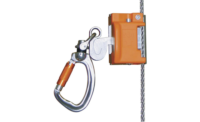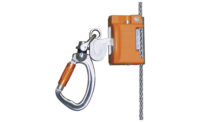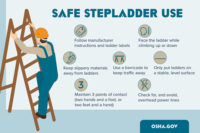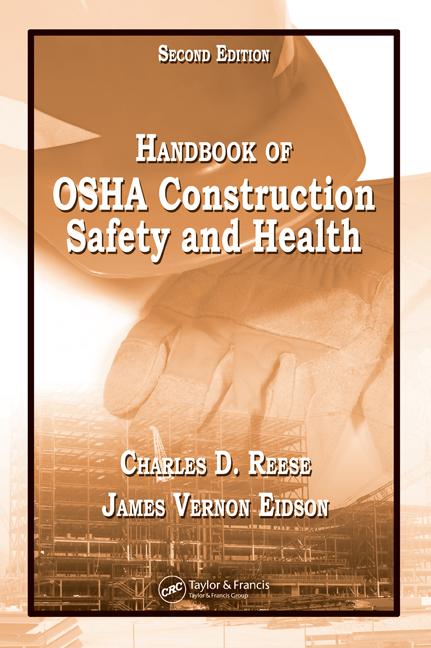Risky ladder climbing catches OSHA’s eye
Throughout 2014, ISHN will report in each issue on one of the 12 most frequently cited OSHA standards, for fiscal year 2013, ending September 30, 2013.

Ladder enforcement totals for all industries: citations (3,328), inspections (2,634), penalties ($4,382,427).
Excerpts from OSHA standard 1926.1053 (construction) – Ladders
• 1926.1053(a)(1) Ladders shall be capable of supporting the following loads without failure:
• 1926.1053(a)(1)(i) Each self-supporting portable ladder: At least four times the maximum intended load, except that each extra-heavy-duty type 1A metal or plastic ladder shall sustain at least 3.3 times the maximum intended load. The ability of a ladder to sustain the loads indicated in this paragraph shall be determined by applying or transmitting the requisite load to the ladder in a downward vertical direction. Ladders built and tested in conformance with the applicable provisions of appendix A of this subpart will be deemed to meet this requirement.
• 1926.1053(a)(1)(ii) Each portable ladder that is not self-supporting: At least four times the maximum intended load, except that each extra-heavy-duty type 1A metal or plastic ladder shall sustain at least 3.3 times the maximum intended load. The ability of a ladder to sustain the loads indicated in this paragraph shall be determined by applying or transmitting the requisite load to the ladder in a downward vertical direction when the ladder is placed at an angle of 751/2 degrees from the horizontal. Ladders built and tested in conformance with the applicable provisions of appendix A will be deemed to meet this requirement.
• 1926.1053(a)(1)(iii) Each Fixed ladder: At least two loads of 250 pounds (114 kg) each, concentrated between any two consecutive attachments (the number and position of additional concentrated loads of 250 pounds (114 kg) each, determined from anticipated usage of the ladder, shall also be included), plus anticipated loads caused by ice buildup, winds, rigging, and impact loads resulting from the use of ladder safety devices. Each step or rung shall be capable of supporting a single concentrated load of at least 250 pounds (114 kg) applied in the middle of the step or rung. Ladders built in conformance with the applicable provisions of appendix A will be deemed to meet this requirement.
• 1926.1053(a)(2) Ladder rungs, cleats, and steps shall be parallel, level, and uniformly spaced when the ladder is in position for use.
• 1926.1053(a)(7) Ladders shall not be tied or fastened together to provide longer sections unless they are specifically designed for such use.
• 1926.1053(b)(1) When portable ladders are used for access to an upper landing surface, the ladder side rails shall extend at least 3 feet (.9 m) above the upper landing surface to which the ladder is used to gain access; or, when such an extension is not possible because of the ladder’s length, then the ladder shall be secured at its top to a rigid support that will not deflect, and a grasping device, such as a grabrail, shall be provided to assist employees in mounting and dismounting the ladder. In no case shall the extension be such that ladder deflection under a load would, by itself, cause the ladder to slip off its support.
• 1926.1053(b)(3) Ladders shall not be loaded beyond the maximum intended load for which they were built, nor beyond their manufacturer’s rated capacity.
• 1926.1053(b)(5)(i) Non-self-supporting ladders shall be used at an angle such that the horizontal distance from the top support to the foot of the ladder is approximately one-quarter of the working length of the ladder (the distance along the ladder between the foot and the top support).
• 1926.1053(b)(5)(iii) Fixed ladders shall be used at a pitch no greater than 90 degrees from the horizontal, as measured to the back side of the ladder.
• 1926.1053(b)(6) Ladders shall be used only on stable and level surfaces unless secured to prevent accidental displacement.
• 1926.1053(b)(21) Each employee shall use at least one hand to grasp the ladder when progressing up and/or down the ladder.
• 1926.1053(b)(22) An employee shall not carry any object or load that could cause the employee to lose balance and fall.
[55 FR 47689, Nov. 14, 1990; 56 FR 2585, Jan. 23, 1991; 56 FR 41794, Aug. 23, 1991; 79 FR 20743, June 10, 2014]
Looking for a reprint of this article?
From high-res PDFs to custom plaques, order your copy today!








